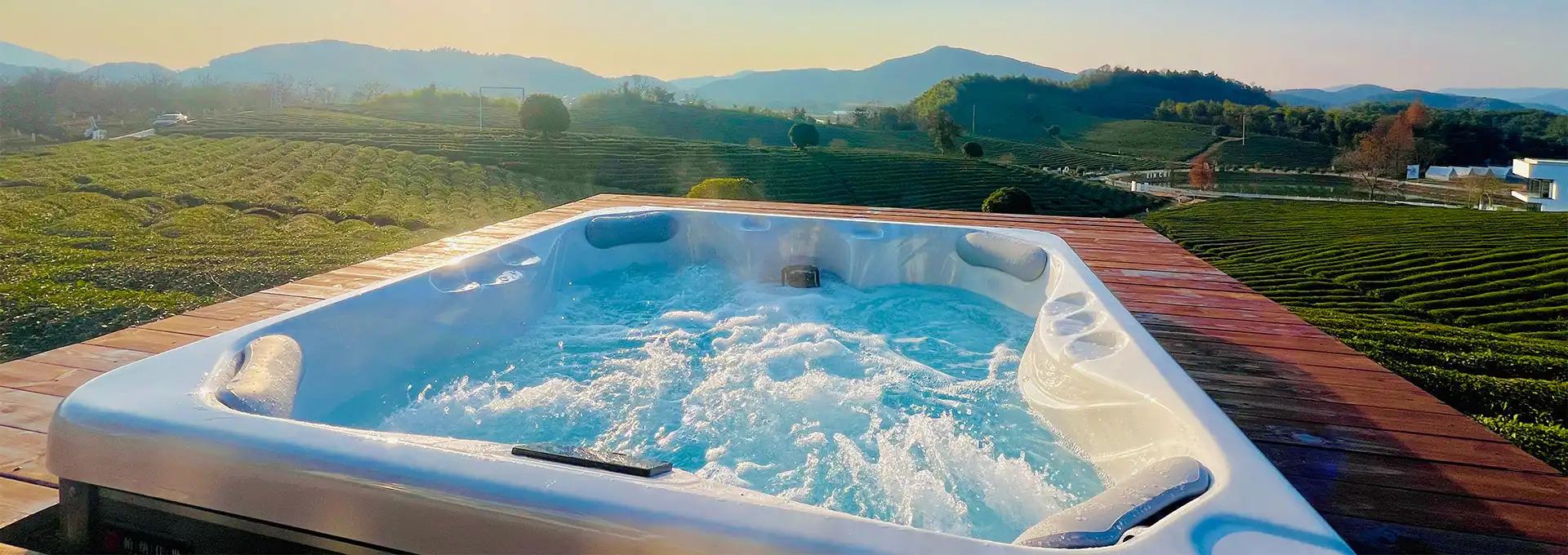How to Lower Stabilizer in Hot Tub?
2025-04-24 13:47:47
Maintaining the proper chemical balance in your hot tub is crucial for ensuring a safe and enjoyable soaking experience. One important aspect of this balance is the stabilizer level, also known as cyanuric acid. While stabilizer helps protect chlorine from breaking down due to sunlight, too much of it can reduce the effectiveness of chlorine and lead to water quality issues. In this blog post, we'll explore how to lower stabilizer levels in your hot tub, with a focus on outdoor hot tubs where stabilizer levels tend to be more of a concern.
What are the signs of high stabilizer levels in an outdoor hot tub?
Cloudy Water
One of the most noticeable signs of high stabilizer levels in an outdoor hot tub is cloudy water. When the cyanuric acid concentration becomes too high, it can interfere with the chlorine's ability to effectively sanitize the water. This can lead to a buildup of contaminants, resulting in a hazy appearance. Outdoor hot tubs are particularly susceptible to this issue due to their exposure to sunlight and environmental factors. To address this problem, it's essential to test your water regularly and maintain proper chemical balance. If you notice persistent cloudiness despite maintaining proper chlorine levels, it may be time to check and potentially lower your stabilizer levels.
Reduced Chlorine Effectiveness
High stabilizer levels can significantly impact the effectiveness of chlorine in your outdoor hot tub. While stabilizer is designed to protect chlorine from rapid degradation due to sunlight, an excess amount can actually "lock up" the chlorine molecules, preventing them from actively sanitizing the water. This phenomenon is known as chlorine lock. As a result, you may find yourself adding more chlorine to your hot tub than usual, yet still struggling to maintain proper sanitation levels. This is particularly problematic for outdoor hot tubs, as they are more exposed to factors that can introduce contaminants. If you notice that your chlorine readings are consistently low despite adding the recommended amount, it may be a sign that your stabilizer levels are too high and need to be addressed.
Skin and Eye Irritation
Another indicator of high stabilizer levels in your outdoor hot tub is increased skin and eye irritation among bathers. While cyanuric acid itself is not typically irritating, the imbalance it creates in the water chemistry can lead to discomfort. When stabilizer levels are too high, it can cause the pH of the water to fluctuate, potentially becoming more acidic. This acidity, combined with the reduced effectiveness of chlorine, can result in a less comfortable soaking experience. Users may experience dry, itchy skin, red eyes, or a burning sensation. These symptoms can be particularly noticeable in outdoor hot tubs, where users may already be more sensitive due to exposure to sun and wind. If you or your guests consistently experience these issues after using your hot tub, it's worth checking your stabilizer levels and taking steps to lower them if necessary.
How can you test stabilizer levels in an outdoor hot tub?
Using Test Strips
One of the most convenient and accessible methods for testing stabilizer levels in your outdoor hot tub is by using test strips. These strips are specially designed to measure cyanuric acid concentrations and are widely available at pool and spa supply stores. To use them, simply dip a strip into your hot tub water for a few seconds, then compare the color change to the chart provided on the packaging. This method is quick and easy, making it ideal for regular monitoring of your outdoor hot tub's water chemistry. However, it's important to note that while test strips are convenient, they may not be as accurate as other testing methods, especially at higher stabilizer concentrations. For the most reliable results, use fresh test strips and follow the manufacturer's instructions carefully.
Liquid Test Kits
For a more accurate measurement of stabilizer levels in your outdoor hot tub, consider using a liquid test kit. These kits typically involve adding reagents to a water sample and observing the resulting color change. Liquid test kits are generally more precise than test strips and can provide a more detailed analysis of your water chemistry. To use a liquid test kit for stabilizer measurement, you'll need to collect a water sample from your outdoor hot tub, add the specified reagents, and compare the resulting color to a provided chart or use a color comparator. While this method requires a bit more time and effort than test strips, it can provide more reliable results, especially for higher stabilizer concentrations. This accuracy is particularly important for outdoor hot tubs, where maintaining proper chemical balance can be more challenging due to environmental factors.
Professional Water Testing
For the most accurate and comprehensive analysis of your outdoor hot tub's water chemistry, including stabilizer levels, consider taking a sample to a professional for testing. Many pool and spa supply stores offer free or low-cost water testing services using advanced equipment. These tests can provide highly accurate readings of various chemical parameters, including cyanuric acid levels. To get the most reliable results, collect your water sample properly: use a clean container, take the sample from about 18 inches below the water surface, and avoid areas near return jets or skimmers. Bring the sample to the testing facility as soon as possible, ideally within a few hours of collection. Professional testing is particularly beneficial for outdoor hot tubs, as it can help identify and address any imbalances caused by environmental factors such as rain, debris, or excessive sunlight exposure.
What are effective methods to lower stabilizer levels in an outdoor hot tub?
Partial Draining and Refilling
One of the most straightforward and effective methods to lower stabilizer levels in your outdoor hot tub is through partial draining and refilling. This process involves removing a portion of the existing water and replacing it with fresh water, effectively diluting the concentration of cyanuric acid. To begin, test your current stabilizer levels to determine how much water needs to be replaced. As a general rule, if you drain and refill half of your hot tub water, you'll reduce the stabilizer level by approximately half. For outdoor hot tubs, it's important to consider the timing of this process. Choose a day with mild weather to minimize the impact of environmental factors on your newly balanced water. Remember to adjust other chemical levels after refilling, as the fresh water will affect the overall balance. While this method can be time-consuming, it's a reliable way to reduce stabilizer levels without the need for harsh chemicals or specialized equipment.
Using a Reverse Osmosis System
For a more advanced approach to lowering stabilizer levels in your outdoor hot tub, consider using a reverse osmosis (RO) system. This method involves passing the hot tub water through a semi-permeable membrane that removes dissolved solids, including cyanuric acid. While typically used for larger pools, smaller RO systems suitable for hot tubs are available. The process can be more efficient than partial draining and refilling, as it can remove a higher percentage of stabilizer without wasting as much water. However, it's important to note that RO systems can be expensive and may require professional installation. For outdoor hot tubs, this method can be particularly beneficial as it not only reduces stabilizer levels but also removes other contaminants that may have accumulated due to exposure to the elements. After using an RO system, you'll need to rebalance your water chemistry, including adding back necessary minerals that may have been removed during the process.
Natural Reduction Over Time
While not the quickest method, allowing for natural reduction of stabilizer levels over time can be an effective approach for outdoor hot tubs. Cyanuric acid does not evaporate or break down easily, but it can gradually decrease through regular use and maintenance of your hot tub. Splash-out, backwashing (if applicable), and the periodic addition of fresh water during routine maintenance can all contribute to slowly lowering stabilizer levels. This method requires patience and consistent monitoring of your water chemistry. For outdoor hot tubs, factors such as rain and debris can affect this process, potentially accelerating or slowing the reduction of stabilizer levels. To support this natural reduction, consider using non-stabilized chlorine products for routine sanitation, as these won't contribute additional cyanuric acid to your water. While this method may take longer than other approaches, it's a gentle, low-intervention way to manage stabilizer levels in your outdoor hot tub over time.
Conclusion
Maintaining proper stabilizer levels in your outdoor hot tub is crucial for ensuring optimal water quality and a enjoyable soaking experience. By recognizing the signs of high stabilizer levels, regularly testing your water, and employing effective reduction methods, you can keep your hot tub's chemical balance in check. Whether you choose to partially drain and refill, use a reverse osmosis system, or allow for natural reduction over time, the key is consistent monitoring and maintenance. Remember that each hot tub is unique, and what works best for one may not be ideal for another. Always consult your hot tub's manual and consider seeking professional advice for the best results in managing your outdoor hot tub's water chemistry.
For more information on hot tub installations and our products, please feel free to contact us at info@iparnassus.com.
References
- Johnson, A. (2021). The Complete Guide to Hot Tub Water Chemistry. Aqua Magazine.
- Smith, B. (2020). Understanding Cyanuric Acid in Outdoor Spas. Pool & Spa News.
- Davis, C. (2019). Stabilizer Management for Outdoor Hot Tubs. Spa & Pool Journal.
- Thompson, E. (2022). Balancing Act: Maintaining Chemical Levels in Outdoor Spas. Hot Tub Owner's Manual.
- Wilson, G. (2018). The Role of Cyanuric Acid in Hot Tub Maintenance. Water Chemistry Today.
- Brown, H. (2021). Effective Methods for Reducing Stabilizer Levels in Spas. Pool & Hot Tub Alliance Publication.
Send Inquiry
Related Industry Knowledge
- Redefining Hotel Hot Tubs with Advanced Water Treatment Solutions
- Hot Tub Maintenance: A Guide for Middle Eastern Hoteliers
- Can a Heart Patient Get in a Hot Tub?
- How Thick Should Concrete Be for a Hot Tub?
- What Chemicals are in a Hot Tub?
- How Many Watt Generator to Run Large Hot Tub?
- Can I Keep My Hot Tub Cool?
- What Are the Maintenance Requirements For a 7 Person Swim Spa?
- How to Cool Down a Hot Tub Quickly?
- Should jets be on when heating hot tub?



